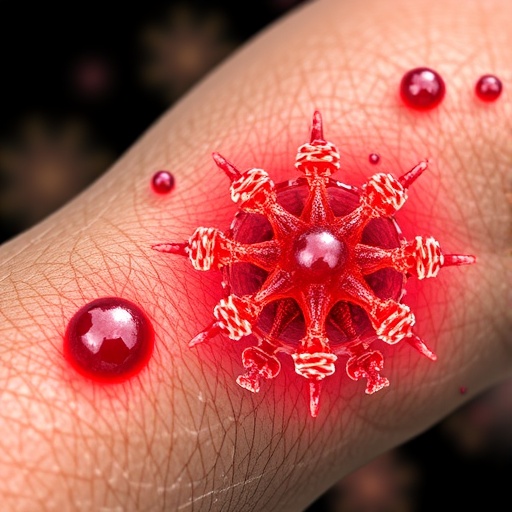In a groundbreaking study set to redefine the landscape of regenerative medicine, researchers have unveiled novel findings regarding the application of nanohydroxyapatite (nHA) synthesized from Elaeagnus angustifolia, which is pronounced as the Russian olive tree. This intriguing research promises a significant advancement in the field of wound healing, specifically targeting the improvement of human dermal fibroblast efficacy. The work, led by a team of scientists, including Azaryan, Ghodousi, and Hanafi-Bojd, showcases how integrating crocin—a natural compound derived from saffron—can remarkably enhance the healing properties of nHA, potentially offering new therapeutic avenues for treating chronic wounds.
The motivation behind this study stems from the ongoing challenges faced in wound care, particularly when dealing with chronic wounds that refuse to heal. Conventional treatments often fall short, leading to prolonged suffering for patients. In response, the researchers turned their focus toward nHA, owing to its biocompatibility and similarity to human bone mineral composition. The innovative approach harnesses both the biological advantages of nHA and the natural healing properties of crocin, creating a synergistic effect that has piqued the interest of the scientific community.
The synthesis of nHA from Elaeagnus angustifolia is a remarkable feat in itself. This plant is known for its resilience and adaptability, thriving in various climates and terrains. By extracting materials from this hardy tree, the researchers tapped into an underutilized resource, promoting sustainability in the production of biomaterials for medical applications. The resultant nHA exhibits properties that aid in cellular proliferation and migration, two critical processes in the wound healing cascade.
Crocin, the star compound in this study, contributes to the enhanced wound healing capabilities of the nHA. Known for its antioxidant properties, crocin not only helps to protect cells from oxidative stress but also promotes fibroblast activity. The fibroblast is a crucial cell type in the dermal layer of the skin, responsible for producing collagen and extracellular matrix. By loading crocin onto the nHA, the researchers have effectively crafted a powerful composite that aims to accelerate the wound healing process while minimizing scarring.
In the in vitro studies conducted, human dermal fibroblasts were cultivated in a controlled laboratory setting, simulating a wound environment. The experimental group, which received the nHA-crocin composite, exhibited significantly more rapid wound closure compared to control groups lacking the treatment. This promising outcome signifies that the combination of these two naturally-derived materials could hold the key to more effective wound management strategies in clinical settings.
Beyond just wound healing, this innovation encompasses the broader implications of utilizing plant-based materials in the biomedical field. The use of natural resources not only reduces reliance on synthetic products, which can often invoke adverse effects but also aligns with the growing trend toward eco-friendly and sustainable practices in healthcare. The use of Elaeagnus angustifolia as a source of nHA embodies this philosophy, potentially setting a precedent for future research.
The biomimetic properties of nHA closely mimic those found in natural bone, making it particularly appealing for applications not just limited to wound healing, but also for bone regeneration and dental applications. As researchers continue to explore its full potential, the integration of crocin may lead to innovative treatments that could revolutionize how we approach not only skin injuries but also various musculoskeletal disorders.
This research highlights the increasing importance of interdisciplinary collaboration in advancing scientific knowledge. The team behind this study amalgamated expertise from fields such as materials science, biochemistry, and cellular biology to achieve these notable results. Such collaborative efforts are vital as they foster diverse thinking and solutions that can significantly impact patient care and treatment modalities.
While the results from this study are promising, the research team acknowledges that further investigation is required to fully understand the mechanisms at play. Future studies will delve deeper into the biochemical pathways activated by the nHA-crocin composite, potentially uncovering additional therapeutic benefits and applications. As scientific inquiry delves deeper into the intricate processes of healing, the hope is to develop refined protocols that maximize patient outcomes.
Moreover, this innovative approach raises questions about the scalability and cost-effectiveness of the production of the nHA-crocin composite. As the medical community seeks to integrate advanced materials into routine clinical care, it becomes essential to analyze how these products can be manufactured affordably and efficiently, ensuring that they are accessible to the patients who need them most.
The promise of this research extends beyond the immediate findings, touching upon larger themes of how new technologies can reshape existing paradigms within medicine. As regenerative medicine continues to evolve, studies such as this one pave the way for breakthroughs that embrace nature while leveraging modern science to enhance human health and recovery.
In conclusion, the groundbreaking work conducted by Azaryan, Ghodousi, Hanafi-Bojd, and their esteemed colleagues heralds a new era in wound healing therapies. Their exploration of nanohydroxyapatite synthesized from Elaeagnus angustifolia loaded with crocin offers a vivid glimpse into the potential of combining natural materials with cutting-edge technology. As these innovative solutions move closer to clinical application, they provide a beacon of hope for those battling chronic wounds, promising enhanced healing outcomes and improved quality of life through nature-inspired science.
Subject of Research: Enhanced in vitro wound healing using nanohydroxyapatite synthesized from Elaeagnus angustifolia and loaded with crocin.
Article Title: Enhanced in vitro wound healing of human dermal fibroblasts using nanohydroxyapatite synthesized from Elaeagnus Angustifolia and loaded with crocin.
Article References:
Azaryan, E., Ghodousi, A., Hanafi-Bojd , M.Y. et al. Enhanced in vitro wound healing of human dermal fibroblasts using nanohydroxyapatite synthesized from Elaeagnus angustifolia and loaded with crocin. BMC Complement Med Ther 25, 396 (2025). https://doi.org/10.1186/s12906-025-05101-8
Image Credits: AI Generated
DOI: 10.1186/s12906-025-05101-8
Keywords: nanohydroxyapatite, Elaeagnus angustifolia, crocin, wound healing, human dermal fibroblasts, regenerative medicine, biocompatibility, sustainable materials.




